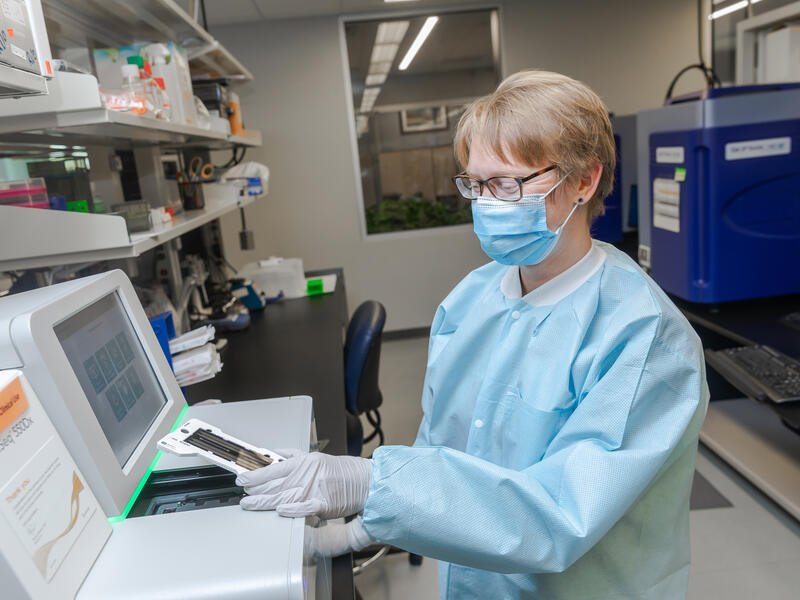The “lab” is a generic term for a wide array of functions and responsibilities that are absolutely necessary in the delivery of health care.
At Sanford Health there are more than 1,100 people who perform laboratory duties. They operate within a wide range of job titles and educational backgrounds but retain a common purpose: providing an essential service that keeps the entire system operating.
Find a program: Medical Laboratory Science at Sanford Health
“We don’t get a lot of limelight because we’re not seen that often,” said Meredith Loosbrock, who is a laboratory education manager and medical lab science program director at Sanford Health.
“A lot of people don’t know that we’re an actual profession or know what we do. We often get lumped in with more well-known professions. When you tell someone you work at a hospital, people think you’re a doctor or a nurse. But when you tell them you work in the lab, you get a blank face looking back at you.”
‘We provide the answers’
Loosbrock enjoys those conversations because it gives her a chance to spread knowledge and awareness to those who want to know more about lab work.
She could tell them the lab work done at Sanford accounts for more than 8 million test results per year. She could include that Sanford lab work follows 54 different transport routes that add up to about 16,000 miles in travel per week.
These numbers translate to countless essential actions taking place within an intricate system. Efficiency and accuracy are constant companions in the process to convert tests to results.
“We play a huge, critical role in patient care, treatment and management,” Loosbrock said. “Ultimately, we provide the answers. We’re kind of like detectives who try to figure out what is truly wrong. We find out what is happening in the body and then we give that information to our front-line providers.”
It’s a career field that encompasses a wide array of responsibilities and job descriptions. They all share indispensability as an attribute, which in this case can mean sustained career opportunities.
“There are multiple levels of education within the laboratory environment,” said Rochelle Odenbrett, senior executive director of Sanford Laboratories. “It can be a very rewarding career. There’s a story behind every patient and we’re part of that story. It’s rewarding to be able to work in the background and play a role in providing answers for physicians.”
Lab workers in demand during pandemic
The presence of the COVID-19 pandemic has served to magnify the efforts of lab workers. During a difficult time in our history they’ve been counted on to provide information vital to our public health.
“If there’s any way to put a positive spin on the pandemic it’s that more people now know what we do,” Odenbrett said. “The word’s getting out on the work we’re doing and how important it is. Individuals are pulling multiple shifts, even at our locations. They’re working longer hours to get those results out because we all know how important they are to the patients and their treatment.”
The U.S. Department of Labor projects steady growth in career opportunities for clinical laboratory technologists and technicians, increasing by 7% nationally through 2029. It’s good news for those who may be considering it as a career.
For medical laboratory scientists and medical laboratory technicians, the job outlook is great, Loosbrock said.
“If you’re an organization looking to hire, you may be struggling because there is a national shortage,” she said.
Nationally, more people who work as an MLS or MLT are reaching retirement age than are entering the profession. Coupled with a rising need for services overall, it means finding lab personnel will continue to be a challenge.
“It all comes down to not enough schools being open for these professions,” Loosbrock said. “That’s the battle we’re dealing with right now. We want more students. We just don’t have the space and the time and the staff to provide that educational background. We have full classes every year between both our programs so we’re doing what we can here at Sanford.”
Medical lab science programs at Sanford
In Fargo and in Sioux Falls, Sanford offers two longstanding medical laboratory science degrees. The Sioux Falls effort began in 1948 with five students and one college affiliation. The two programs now graduate 20 students a year.
In Fargo, Sanford has laboratory science affiliations with North Dakota State and Concordia College. In Sioux Falls, affiliations exist with Augustana, the University of Sioux Falls, University of South Dakota, Northwestern College, Northern State, Minnesota State University Mankato, Southwest Minnesota State and Mount Marty.
In Bismarck, Sanford has an affiliation with Bismarck State College, offering an associate degree MLT program. The partnership includes providing a program director as well as instructors. Since the early 1980s, it has also included internships for students.
In Sioux Falls and Fargo, students spend their first three years on their home campus and then the last year spend 11 months in a Sanford program that combines academics and actual lab experience.
“We give them a great foundation to learn while honing their skills,” Loosbrock said. “When they move on to work independently, they have the confidence and know-how to do that.”
Students in the program can boast 100% completion rates, continual 100% board certification and examination pass rates.
“We are very proud of our program,” Loosbrock said. “We’d like to do more in talking to high school kids to make sure they know that when they get into college this is an option as a career choice. We want to promote the availability of getting a degree in laboratory science, whether it is a two-year degree or a four-year degree.”
Learn more
- COVID-19 Q&A: Inside the test lab with Rochelle Odenbrett
- Sanford’s central lab adapts to flurry of COVID-19 testing
- Sanford provides COVID-19 testing for NBA All-Star events
…
Posted In Allied Health, COVID-19, Fargo, Pathology, People & Culture, Sioux Falls, Undergrad College Resources
